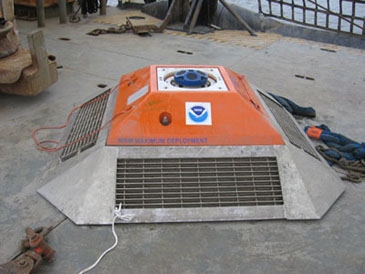Great “rivers” of water flow through the oceans -- currents that can be miles wide and hundreds of feet thick. Plotting their motions helps scientists learn how the oceans transport heat, minerals, and nutrients; how they interact with land; how they affect global climate, and much more.
 An Acoustic Doppler Current Profiler (ADCP) waiting to be deployed on the deck of a NOAA vessel. Credit: National Oceanic and Atmospheric Administration
An Acoustic Doppler Current Profiler (ADCP) waiting to be deployed on the deck of a NOAA vessel. Credit: National Oceanic and Atmospheric AdministrationThere are a couple of main techniques for measuring the speeds of these currents. One is to go with the flow. The other is to sit still and let the flow go by.
The first method uses instruments known as drifters. They’re released into the ocean and allowed to drift with the current. Some stay close to the surface, while others can descend to depths of thousands of feet. Orbiting satellites track their motion, which provides an accurate reading of the speed of the current.
The other method involves attaching instruments to buoys or other platforms. The instruments use the same technique that dolphins use to track prey. They emit high-frequency sound waves, and “listen” for the sound to echo off solid particles that are being carried by the current. The frequency of the “echo” is compressed or stretched depending on whether a particle is moving toward or away from the instrument. The change in frequency reveals the particle’s speed, which in turn reveals the speed of the current that’s carrying it. A similar technique can be used from shore, or even from space.
These techniques reveal that while ocean currents are relentless, they’re not very fast: The fastest currents in the open ocean top out at about five miles per hour.

